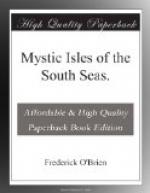Port Phaeton is famed in the annals of the early French conquerors, for in it they anchored their warships, and the Paris chauvinists dreamed of a navy-yard and a large settlement there. On the plateau of Taravao, a hilltop raised fifty feet, is an old fort of the French, a solid construction against the stubborn Tahitians whom they insisted, with cannon and musket, must receive Christianity through the French clergy of the Order of the Sacred Heart of Jesus instead of through English dissenters. From the plateau we could see the immense extent of the forests, which rose almost from the water to the tops of the mountains.
A dozen magnificent kinds of trees were all about us. The earth wore a verdant coat of grass, ferns, and vines, so profuse and bright that by contrast a remembrance of the barren parts of America crossed my mind, with the fulsome praise of them by the pious thieves of that region who sell them. It would be impossible and cruel, I reflected, to convey to those extravagants in adjectives the richness of herbage and the brilliancy of scene about the isthmus. The vegetation was ampler than anywhere else in Tahiti.
The tamanu-, the hotu-, and the mape-trees were in abundance. The tamanu yields tacamac, a yellow, resinous substance with a strong odor and a bitter, aromatic taste, that is used as incense and in ointments. The Tahitians call the tamanu the healing-tree. It grows just above high water on any kind of shore, embowering, with dark foliage, and peculiarly easeful in midday on the hot sands. I have had a tamanu-leaf soaked in fresh water laid upon my eye inflamed by too long a vigil in the sun on the reef. The small gray ball within its round green fruit affords a greenish oil that is a liniment of wizardry for bruises, stiffness, rheumatism, and fevers. In every house was a gourd stored with it.
The mape, the Tahitian chestnut, grew farther from the water, a powerful, commanding figure, with flowers of sublimated sweetness, and with it the tiairi, or tutui-tree, covered with blossoms, like white lilac, and bearing nuts with oily kernels. It is the candlenut-tree, which has furnished lights for Tahitians since they wandered to these latitudes. The nuts are baked to make brittle their shell, and the kernels of walnut size easily extracted and pierced. Strung on the midrib of a palm-leaf, the combination makes wax and wick, and has lighted many a council and many a dance in Polynesia.




